14
Public LifeIn 1914 Alfred, now Lord Northcliffe, decided to sell his share in the Daily Mirror to Harold, now Lord Rothermere. In the First World War the Daily Mirror became the most popular newspaper on the Western Front. The soldiers particularly liked the fact that the newspaper included so many pictures of life back home. The newspaper also published a large number of pictures of the war. Probably the most dramatic example was the German daylight air raid over London in 1917. Rothermere loyally gave support to the British government in the war and in 1917 David Lloyd George appointed Rothermere as his Air Minister. He was made Viscount Rothermere of Hemsted in the County of Kent in 1919.
Rothermere continued his involvement in political life after the First World War through his papers and his personal connections. He was strongly opposed to communism and promoted this stance vigorously. Four days before the 1924 General Election, Rothermere decided to publish what became known as the Zinoviev Letter which urged British communists to promote revolution through acts of sedition. The letter, later discovered to be a forgery, contributed to the defeat of Ramsay MacDonald and the Labour Government.
Rothermere became increasingly nationalistic in his political views and in 1929 joined with Lord Beaverbrook to form the United Empire Party. Rothermere urged the Conservative Party to remove its leader, Stanley Baldwin, and replace him with Beaverbrook. He also argued for a reform of the House of Lords to make it possible for peers to be elected to the House of Commons. This dispute divided conservative voters and this enabled the Labour Party to win the 1929 General Election.
In the 1930s Rothermere moved further to the right and gave support to Oswald Mosley and the National Union of Fascists. He wrote an article, Hurrah for the Blackshirts, in January, 1934, in which he praised Mosley for his "sound, commonsense, Conservative doctrine".
Rothermere also had several meetings with Adolf Hitler and argued that the Nazi leader desired peace. In one article written in March, 1934, he called for Hitler to be given back land in Africa that had been taken as a result of the Versailles Treaty.
Rothermere and his newspapers supported Neville Chamberlain and his policy of appeasement. He was therefore devastated when war broke out between Britain and Germany in 1939. He leant his efforts to the Allied cause, however, and in 1940, Baron Beaverbrook sent Harmsworth on a special war mission to Canada and the United States. Following this effort, he went to Bermuda for a rest where he took ill and died of dropsy at the age of 72.
15
Harold Harmsworth: Public LifeCirca 1939
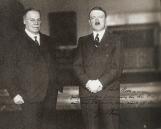 Credits:
Credits:Taylor, S.J. The Great Outsiders; Northcliffe, Rothermere and The Daily Mail. Copyright © S.J. Taylor, 1996
16
The Blenheim BomberSo firm had been the Mail's backing for the conquest of the air prior to 1914 that Harold, by then Viscount Rothermere, became Britain's first Secretary of State for Air during the Great War. His interest continued during the inter-war period and, in 1934, a Mercury-engined version of the Bristol Type 135 cabin monoplane was ordered by Rothermere for his own use as part of a campaign to popularise commercial aviation. First flying in 1935, the Bristol Type 142 caused great interest in Air Ministry circles because its top speed of 307 mph was higher than that of any Royal Air Force fighter in service. Lord Rothermere presented the prototype (named "Britain First") to the nation for evaluation as a bomber and in early 1936 the modified design was taken into production as the Blenheim Mk.I. It was mass produced in readiness for the war that eventually came in 1939, and played a crucial role in the Battle of Britain. It was a Blenheim that flew the first sortie of the war and was the first plane to sink both a U?boat and a Japanese submarine.
17
Lord Rothermere and the Bristol Blenheim BomberCirca 1930s
 Credits:
Credits:http://www.youtube.com/watch?v=aM60r3kEmaQ
18
King of HungaryAfter the First World War, developments in Hungary were determined above all by the peace treaty signed in the Grand Palace of Versailles on June 4, 1920, known as the Treaty of Trianon. The terms of this treaty were extremely harsh and punitive for the losing side, especially Hungary. On the basis of this treaty, Hungary lost 71.4% of her territory and 63.6% of her population.
Harmsworth strongly supported revision of the Treaty of Trianon in favor of Hungary. During the 1920s, he led a campaign to help Hungary regain its land that had been given to Serbia, Romania, and Czechoslovakia as part of the country's punishment for participating in World War I on the side of the aggressors. He became so popular in Hungary because of his very public position in private and through his papers that he was offered the Hungarian Crown in 1927. He declined, but purchased estates in Hungary in case Britain should fall to a Soviet invasion. There is a memorial to Harmsworth in Budapest.
19
Harold Harmsworth: King of Hungarycirca late 1920s
Budapest, Hungary
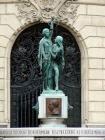 Credits:
Credits:http://magnasfertaly.blogspot.com/2009/06/egy-angol-lord-aki-igazsagot-kovetelt.html
21
Affection from Hungarian Troops1927
Location unknown
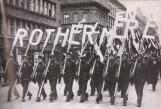 Credits:
Credits:Taylor, S.J. The Great Outsiders; Northcliffe, Rothermere and The Daily Mail. Copyright © S.J. Taylor, 1996
22
The Nazi TieLord Rothermere was acquainted with both Benito Mussolini and Adolf Hitler, which influenced the Mail's political stance towards them during the 1930s. Rothermere's 1933 leader, "Youth Triumphant", praised the new Nazi regime's accomplishments, and this public acknowledgement was subsequently used as propaganda by them.
Rothermere and the Mail were also editorially sympathetic to Oswald Mosley and the British Union of Fascists. Rothermere wrote an article entitled "Hurrah for the Blackshirts" in January 1934, praising Mosley for his "sound, commonsense, Conservative doctrine". This support ended after violence at a BUF rally in Kensington Olympia later that year.
This kind of support for the Fascist movement was not uncommon in Great Britain at the time. This was fuelled by an overwhelming fear of communism and a fear of a repeat of the horrors of World War I. Although Harmsworth continued to support a policy of appeasement right up to the outbreak of World War II, he quickly threw his support behind the Allied endeavour and was serving in the cause of Great Britain when he died in 1940.
23
Harold Harmsworth: The Nazi TieCirca 1939
 Credits:
Credits:Rothermere, Lord (Harmsworth, Harold). Warnings and Predictions. Eyre and Spottiswoode, London, 1939.
24
Harold Harmsworth: Lord RothermereCirca 1930s
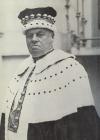 Credits:
Credits:Ferris, Paul. The House of Northcliffe: The Harmsworths of Fleet Street. Weidenfeld and Nicolson, London, 1971.
25
Stone Slab to the memory of Viscount RothermereEarly 1900s
Grand Falls-Windsor, Newfoundland, Canada
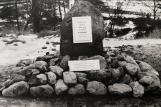 Credits:
Credits:Grand Falls Windsor Heritage Society A.N.D Collection
